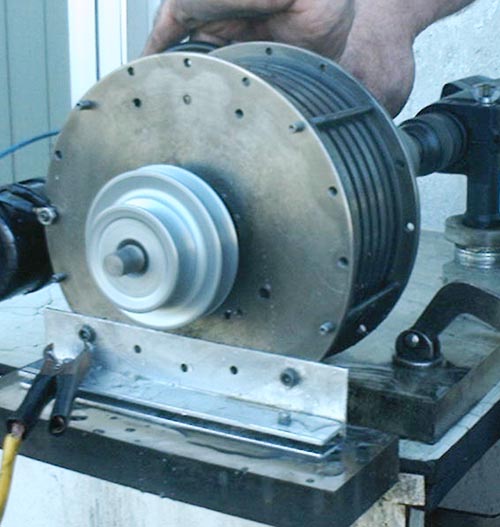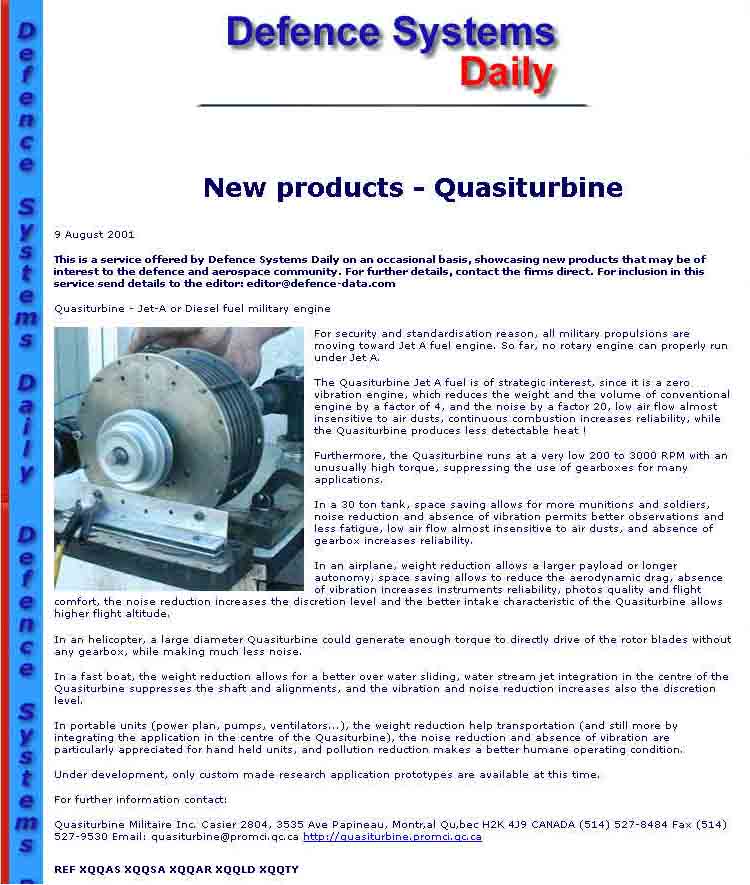
Quasiturbine
Jet-A or Diesel fuel military engine
... even more that jet or Diesel...
With a potential of 10 HP per pounds or more in pneumatic or steam mode,
the Quasiturbine is an exceptional candidate for the marine supercavitating vehicles burning metal fuels (aluminum, magnesium or lithium)
http://www.sciam.com/2001/0501issue/0501ashley.html
Aluminum is the most energetic of these metal fuels, producing a reaction temperature of up to 10,600 degrees Celsius.
One can accelerate the reaction by fluidizing the metal and using water vapor.
The heat from the combustion chamber would be used to melt stored aluminum sheets at about 675 degrees C and to vaporize
water as well.
High-pressure steam from this combustion process expands out to drive a Quasiturbine
(?) that turns a propeller screw.
This would be an extremely high power density aluminum-burning "water ramjet"
system.
The Quasiturbine theory analyses and optimizes 14 different engine parameters (see the book).
For security and standardization
reason, all military propulsions are moving toward Jet A fuel engine.
So far, no rotary engine can properly run under Jet A.
The Quasiturbine Jet A fuel is of
strategic interest, since it is a :
zero vibration engine,
which reduces the weight and the volume of conventional engine by a factor of
4,
and the noise by a factor 20,
low air flow almost
insensitive to air dusts,
continuous combustion increases reliability,
while the Quasiturbine produces less detectable heat !
Possible zero EMF
(Electro-Magnetic Field) engine operation.
Furthermore, the Quasiturbine runs
at a very low 200 to
3000 RPM (meaning a very long engine live time)
with an unusually high torque,
suppressing the use of gearboxes for many applications.
Due to steep pressure rise in the Quasiturbine,
the use of synchronized conventional injectors may not be necessary for some
applications.
Submersible without crankcase nor electrical circuit.
Hybrid Quasiturbine-Fan (or Quasiturbine-Jet)
No temperature limit in the jet nozzle!
Considering the high power density, the
low cross section area and the exceptional intake characteristics of the
Quasiturbine,
it is reasonable to expect to conceive an airplane engine:
1) Quasiturbine-Fan
in which the Fan would
be driven by a Quasiturbine,
rather that by a conventional power turbine.
2) Quasiturbine-Fan Hybrid
in which only the compressor would be driven by a Quasiturbine,
leaving all the reactor energy available to drive a still more powerful Fan.
The Quasiturbine air intake could come from the compressor.
3) Quasiturbine-Jet reactor (no hot turbine)
Still more revolutionary would be a Jet Reactor without power
turbine in the hot gas flow,
where the compressor would be driven by a Quasiturbine, leaving to the Jet all
its propulsive energy.
The Quasiturbine air intake could come from the compressor.
In this last case, the suppression of the
conventional power turbine
would permit to operate the engine at much higher temperature without risking to
melt the non-existent power turbine,
and would permit to substantially increase the efficiency.
This airplane engine would operate in the same mode as the rocket engines!
For still a higher power density,
the Quasiturbine could be fueled in pneumatic
mode in hydrogen peroxide.
Those concepts would also permit to construct much less
complicated airplane engines
and at a much lower cost than conventional turbines.

Various military applications
In a 30 tons tank, space saving
allows for more munitions and soldiers,
noise reduction and absence of vibration permits better observations and less
fatigue,
low air flow almost insensitive to
air dusts,
and absence of gearbox increases reliability.
In a propeller airplane, weight reduction
allows a larger payload or longer autonomy,
space saving allows to reduce the aerodynamic drag,
absence of vibration increases instruments reliability, photos quality and
flight comfort,
the noise reduction increases the discretion level,
the high torque allows the use of multi-blades propeller
and the better intake characteristic of the Quasiturbine allows higher flight
altitude.
The hybrid Quasiturbine-Fan (or Quasiturbine- Jet) engine
would be more powerful and efficient.
See: http://quasiturbine.promci.qc.ca/QTULM.html
In an helicopter, a large diameter
Quasiturbine could generate enough torque
to directly drive of the rotor blades without any gearbox, while making much less noise.
The weight reduction of any equipment using a Quasiturbine make it more
suitable for helicopter transportation.
In a fast boat, the weight reduction allows for a better
over water surfing,
water stream jet integration in the center of the submersible Quasiturbine suppresses the
shaft and alignments,
and the vibration and noise reduction increases also the discretion level.
Outboard marine submersible Quasiturbine can also be of great interest.
In a pneumatic sub-marine,
everything is outside the habitacle:
the air tanks are underneath as emergency lest,
the Quasiturbine submersible jet propulsion is remote behind,
and the Quasiturbine air exhaust is feed inside and respirated by the crew!
In a nuclear sub-marine, a steam
Quasiturbine
http://quasiturbine.promci.qc.ca/QTVapeur.html
would produce the necessary torque to directly drive the propeller shaft
without delay in both directions (reversing the flow),
and would allow for a complete and quite stop.
In a torpedo, a 1000
hp hydrogen peroxide fueled Quasiturbine would be more compact and lighter,
with a larger range, and producing an efficient multi-power level output (which
conventional turbine can not allows).
In terrestrial multi-wheels
drive vehicles, independent pneumatic or hydraulic Quasiturbines
can be all
connected to one central pressure distribution point
such as to generate equal torque
independently from the individual RPM.
Torque modulation can further provide the vehicle direction control.
In portable units (power plan, pumps,
ventilators...),
the weight reduction help transportation (and still more by integrating the
application in the center of the Quasiturbine),
the noise reduction and absence of vibration are particularly appreciated for
hand held units,
and pollution reduction makes a better humane operating condition.
In precision guided device,
the low harmonic Quasiturbine engine
permits a precise RPM, power and acceleration control over a wider
range.
For zero
EMF (Electro-Magnetic Field) engine operation,
the Quasiturbine offers 5 modes: pneumatic, steam,
continuous combustion, diesel and photo-detonation.
For stealth
operation, a plastic made Quasiturbine is radar
undetected
with a noise 20 time less than the conventional engine,
and in pneumatic mode, the exhaust can be near ambient temperature, with
zero EMF.
Under development,
only RESEARCH APPLICATION PROTOTYPES
are custom made available at this time.
Published by Defence Systems Daily at : http://defence-data.com/current/page11838.htm (expired)

| Return to main menu |
Quasiturbine Militaire Inc.
Casier 2804, 3535 Ave Papineau, Montréal Québec H2K 4J9 CANADA (514) 527-8484 Fax (514)
527-9530
http://quasiturbine.promci.qc.ca
quasiturbine@promci.qc.ca